University of Oxford
![]()
Oxford University is a redirect to this article. For the other university in Oxford, see Oxford Brookes University.
51.7611111111-1.25333333333Coordinates: 51° 45′ 40″ N, 1° 15′ 12″ W
The University of Oxford (legally The Chancellor, Masters and Scholars of the University of Oxford) in Oxford, England, is one of the oldest and most prestigious universities in the world. The university is legally constituted as a corporation.
It is the oldest university in the English-speaking world and has been in existence since the 12th century. It is divided into 39 Colleges and six Permanent Private Halls. All colleges are self-governing bodies within the university, each controlling their own membership, internal structures and activities.
The University of Oxford is ranked among the best universities by most international and UK rankings. Together with the University of Cambridge, Imperial College London, the London School of Economics and Political Science (LSE) and University College London (UCL), the University of Oxford forms the so-called super-elite group of G-5 universities in England, making it one of the top universities. It is a member of the UK's Russell Group of research universities.
Oxford has produced a handsome number of notable alumni, including 28 UK Prime Ministers and numerous international heads of state and government. As of November 2019, 55 Nobel Laureates, 3 Fields Medal winners and 6 Turing Prize winners have studied or worked at the University. Alumni of the University have won 160 Olympic medals. Oxford is home to numerous scholarships, including the Rhodes Scholarship, one of the oldest international graduate scholarship programmes.
History
Foundation
The University of Oxford (Latin: Universitas Oxoniensis) has no known date of foundation. The earliest evidence of teaching at Oxford are letters from a schoolmaster who began teaching there around 1096. The university expanded around 1167, as King Henry II had forbidden Englishmen to attend the University of Paris. With the University of Paris and the University of Bologna, Oxford is one of the oldest European universities. The historian Giraldus Cambrensis lectured at the university as early as 1188 and the first foreign scholar, Emo of Wittewierum, arrived at Oxford in 1190. The head of the university has held the title of Chancellor since at least 1201. Oxford University received Royal Charter in 1248 during the reign of King Henry III.
One of the oldest documents about the university moderated its revival after a rift with the city and was written by a legate of the pope in 1214. The cause of this rift was an execution in 1208 or 1209, which led some scholars to flee to Cambridge and later found the University of Cambridge. Since the creation of the University of Cambridge, these two universities, collectively known as Oxbridge, have shaped the intellectual life of Britain.
Students formed two nations based on their geographical origins, representing the north (northerners or boreales, which included Englishmen north of the River Trent and Scots) and the south (southerners or australians, which included Englishmen south of the River Trent, Irish and Welsh). In later centuries, geographical origin continued to influence the affiliation of many students when membership of an Oxford College or Hall became common. In addition, members of many religious orders settled in Oxford in the mid-13th century, including Dominicans, Franciscans, Carmelites, and Augustinians, and maintained lodgings or Halls for students. Around the same time, private benefactors established colleges as independent teaching institutions. Among the earliest such benefactors were William of Durham, who endowed University College in 1249, and John Balliol, father of the future Scottish king and namesake of Balliol College. Walter of Merton, later Bishop of Rochester, developed a set of regulations for life at Merton College. It thus became the model for such institutions at Oxford as well as at the University of Cambridge. Thereafter, more and more students lived in colleges rather than in Halls and religious houses. In 1355, the most devastating conflict to date occurred between students and townspeople.
In 1333/1334 an attempt by some disaffected scholars to found a new university in Lincolnshire Stamford was blocked by the universities of Oxford and Cambridge. Thereafter, no new universities were allowed to be founded in England until the 1820s. This left Oxford and Cambridge with a duopoly that was unusual for large Western European countries.
Renaissance
Renaissance values greatly influenced Oxford from the late 15th century onwards. Scholars of this period included William Grocyn, who contributed to the revival of Greek linguistics, and John Colet, an influential biblical scholar.
In the course of the English Reformation and its break with the Roman Catholic Church, some Oxford scholars fled to continental Europe and settled there, primarily at the University of Douai. Teaching at Oxford was converted from the medieval scholastic method to the educational methods of the Renaissance, although the university suffered significant losses of land and income. As a center of learning, Oxford's reputation declined during the Age of Enlightenment. Enrollments declined and teaching was neglected. The University of Oxford, as well as the University of Cambridge, experienced extensive liberties and were elevated to corporations by Elizabeth I's Oxford and Cambridge Act in 1571.
In 1636 William Laud, Chancellor of the University and Archbishop of Canterbury, codified the statutes of the University. These were largely preserved until the mid-19th century. Laud was responsible for securing privileges for the University Press and made significant contributions to the Bodleian Library, the University's main library. From the founding of the Church of England until 1866, membership in the church was a requirement to receive an undergraduate degree from the university. Those of other faiths were not allowed to receive a Master of Arts until 1871.
The university was a centre for royalists during the English Civil War (1642-1649), while the town supported opposing parliamentarians. Charles I sought refuge at Christ Church and used the college as his residence during the Civil War. The loyalist rump parliament met in Christ Church's dining hall. From the mid-18th century, however, the university took little part in political conflict.
Founded in 1610, Wadham College was the college of Christopher Wren. Wren was part of a group of experimental scientists at Oxford in the 1650s, the Oxford Philosophical Club, which also included Robert Boyle and Robert Hooke. This group held regular meetings at Wadham under the leadership of John Wilkins and formed the nucleus which later gave rise to the Royal Society.
Women and Oxford
Until 1878, women were forbidden to study at Oxford colleges. In 1878 Lady Margaret Hall and in 1879 Somerville College, the first all-women's colleges were founded, ten years after the first colleges for women were established at Cambridge. Lady Margaret Hall and Somerville first opened their doors in 1879 to their first 21 female students (12 from Somerville, 9 from Lady Margaret Hall), who had to attend lectures in rooms above an Oxford bakery. 25 more female students, who lived at home or with friends, formed the Society of Oxford Home-Students, which evolved into St Anne's College in 1952.
This was followed in the late 19th century by the founding of St Hugh's College and St Hilda's College. All of these colleges later became co-educational, starting with Lady Margaret Hall and St Anne's in 1979. The last all-female college was St Hilda's, which since 2008 now accepts male applicants. In the early 20th century, Oxford and Cambridge were largely seen as bastions of male privilege. The integration of women at Oxford was advanced during the First World War, and women were admitted as equal medical students in 1916. In 1917, the university assumed financial responsibility for examinations taken by women.
It was not until October 7, 1920 that women were also allowed to earn the same academic degrees as their male peers. In 1927, the university's dons created a quota that limited the number of female students to a quarter of the number of male students. This regulation was not lifted until 1957. At that time, since all Oxford colleges admitted students of only one sex, the number of female students was nevertheless limited by the admission capacity of the women's colleges. It was not until 1959 that women's colleges were granted status as full colleges of the university. Several colleges were founded or co-founded by women, such as BalliolCollege and Wadham College.
In 1974 Brasenose, Hertford, Jesus, St Catherine's and Wadham were the first men's colleges to admit women. The majority of men's colleges admitted their first female students in 1979. Christ Church followed in 1980 and Oriel was the last men's college to admit women in 1985. Most postgraduate colleges in Oxford were founded in the 20th century as co-educational institutions, with the exception of St Antony's which was founded as a men's college in 1950 and only began admitting women in 1962. The proportion of female students at Oxford in 2018 was 51.2%. Women made up 19% of professors in 2019.
Women were admitted to the Oxford Union in 1908. The first female president of the Oxford Union was Benazir Bhutto in 1977, who studied at Lady Margaret Hall. On 28 May 2015, Louise Richardson was nominated as the University's next Vice-Chancellor. Subject to Congregational approval, Richardson took up her post on 1 January 2016, succeeding Andrew Hamilton. This first nomination of a woman to the position is considered a milestone in the University's history.

Mob Quad of Merton College - the oldest quad of the university
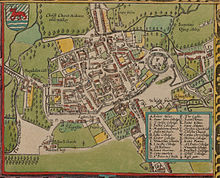
In 1605 Oxford was still a walled city (The north is at the bottom of this map).
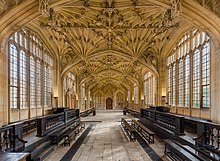
Divinity School - The University's oldest surviving purpose-built building.
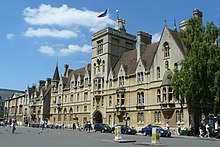
Balliol College - one of the oldest constituent colleges of the University.
Academic profile
Approval
In 2019, out of a total of 23,020 applicants, 3,280 were admitted for undergraduate study. This equates to an admission rate of 14.24%, making Oxford University one of the most selective in the UK. The total number of applications has seen a growth of 25.3% since 2015. The courses with the most applicants per place between 2017 and 2019 include Economics and Management (16.3 applicants per place), Computer Science (14.8 applicants per place) and Medicine (10.8 applicants per place). In 2019, the University saw the largest increase in applications from non-EU applicants. The People's Republic of China (3,943 applicants) forms the largest foreign applicant group, followed by the United States (2,179 applicants) and Singapore (1,459 applicants). Germans form the sixth largest applicant group (1,234 applicants) at Oxford.
Students applying to study at Oxford are not admitted by the university itself, but by individual colleges. Students applying for postgraduate study, on the other hand, are admitted by faculties but are still members of a college. The University itself performs only administrative functions.
The university is often criticised for admitting a disproportionate number of students from private schools. In 2016, Oxford University awarded only 59% of its places to students in state schools, while around 93% of all UK students and 86% of UK sixth form students are educated in state schools. The proportion of students from state schools has been steadily increasing. Between 2015 and 2019, the state share of all UK students each year was: 55.6%, 58.0%, 58.2%, 60.5% and 62.3%. Oxford University spends over £6 million annually on programmes to increase the number of applicants from underrepresented populations.
In 2018, the university's annual admissions report revealed that eight Oxford colleges admitted fewer than three black applicants in the last three years. In 2020, the proportion of ethnic minorities admitted reached its record level, rising from 558 to 684 students, representing 23.6% of all UK applicants admitted. The number of black students increased from 80 to 106 students, representing approximately 3.7% of all admitted applicants.
Admission procedure
Oxford University's admissions process is considered to be one of the most demanding in the world. Pre-selection is based on past or predicted examination results, a letter of application, school references and, in some subjects, a written admissions test and/or written work submitted by candidates. Approximately 60% of applicants are shortlisted, although this varies according to the course of study. In the event of a large number of applicants being shortlisted for a course, students may be randomly allocated to another college which still has capacity for the selected course.
In the second round of applications, colleges invite candidates to selection interviews, which take place for about three days in November or December. Most applicants are interviewed individually by academics and tutors from the colleges in one or more interviews. Applicants from outside Europe can complete the selection interviews online. The results of the admissions process are sent out by the colleges in early January. One in four successful applicants will be admitted to a college to which they have not applied. For some courses, candidates may receive an open offer and will not be assigned to a college until August.
Financial support
Students at Oxford have numerous opportunities to receive financial support during their studies. Launched in 2006, the Oxford Opportunity Bursaries is a university-wide, means-tested bursary that provides each UK student with up to £10,235 over three years. In addition, individual colleges offer bursaries to help their students. For postgraduate students, for example, the university offers the Rhodes Scholarship or the relatively new Weidenfeld Scholarship. Oxford also offers the Clarendon Scholarship, which is open to applicants of all nationalities. The Clarendon Scholarship is primarily funded by Oxford University Press in collaboration with some colleges and other partnerships. In 2016, Oxford University announced that it would offer its first free online course as part of a collaboration with a US online university network. The course is called From Poverty to Prosperity: Understanding Economic Development.
Teaching
Studying at Oxford is divided into trimesters. These are eight weeks long and are called Michaelmas (October to December), Hilary (January to March) and Trinity (April to June or July). The trimesters always begin on a Sunday and are designated internally numerically, the first week being known as first week and the last week as eight week. The total teaching time at Oxford is shorter than at most other British universities, being less than half a year. However, students are also expected to do academic work during the three holiday periods (known as Christmas, Easter and Long Vacations).
The focus of undergraduate study is on tutorials, in which one to three students discuss their weekly work within an hour with a tutor. This is usually an essay (humanities, most social sciences and some mathematical, physical and life sciences) or a problem worksheet (physical, mathematical and life sciences and some social sciences). Typically, students have one or two tutorials a week that take place at their own, or another, college of the university. The tutorials are complemented by lectures and seminars organized by the faculties of the university.
Examinations and degrees
The University is responsible for conducting examinations and awarding academic degrees. To obtain an undergraduate degree, two sets of examinations must be passed. The first set of examinations is known as Moderations or Preliminary Examinations and usually take place at the end of the third term; in a few subjects at the end of the second term. The second set of examinations, the Final Honours School (also known as finals), takes place at the end of the undergraduate degree (in the humanities and most social sciences) or at the end of each academic year (in most mathematical and life sciences, and some social sciences).
In the tradition of the University, undergraduate graduates may, seven years after matriculation (formal acceptance into the University) and without further examination, upgrade their degree to a Master ofArts. The "MA" is only associated with the acquisition of rights and privileges at the university and is therefore not equivalent to a postgraduate degree. The system dates back to the Middle Ages, when the study of the liberal arts lasted seven years.
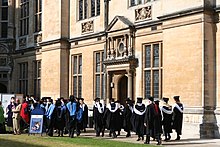
Graduation ceremony at the Examination Schools
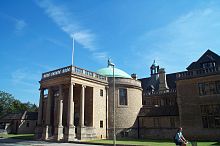
Rhodes House - home of the Rhodes Foundation which awards the prestigious Rhodes Scholarship.
Questions and Answers
Q: What is the University of Oxford?
A: The University of Oxford is a university in Oxford, England. It is the oldest university in the English-speaking world and was ranked as "the best university in the world" by Times Higher Education World University Rankings in the 2000s.
Q: How many colleges does it have?
A: The University of Oxford has 38 colleges and six private halls.
Q: Does it have a campus like most modern universities?
A: No, unlike most modern universities, Oxford does not have a campus. However, there are some central places where students from different colleges can come together (for example, libraries).
Q: What is the Bodleian Library?
A: The Bodleian Library is the main library of the University of Oxford and one of Europe's oldest libraries. It is also the second largest library in Britain after the British Library.
Q: When was it founded?
A: The Bodleian Library was founded in 1602.
Q: Is it open to all students at Oxford? A: Yes, all students at Oxford can use this library for their studies or research purposes.
Search within the encyclopedia
.jpg)
.jpg)